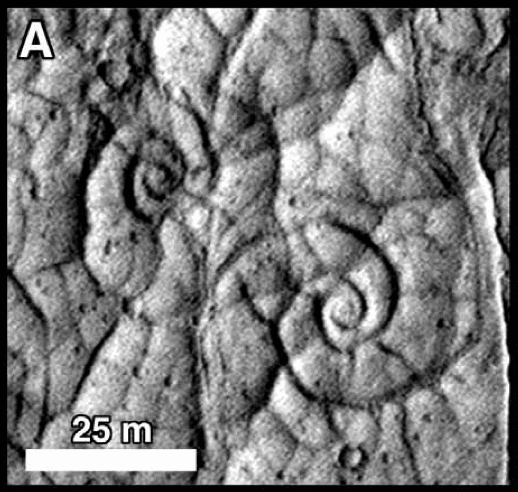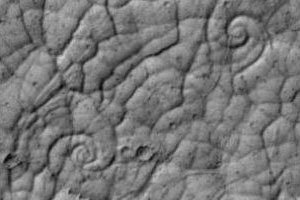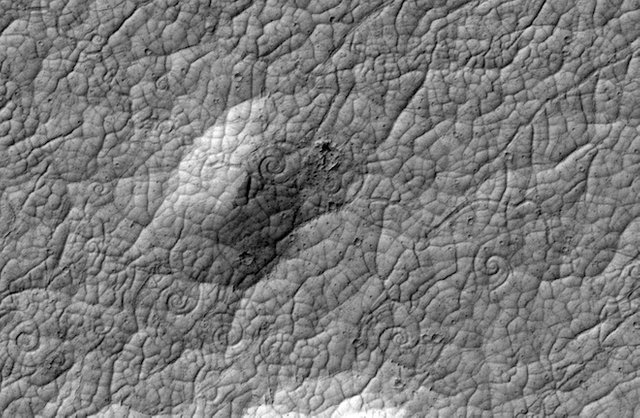Mysterious spirals on Mars! A story of discovery.

Rewind the clock. Fall 2011. I'm a first year phd student at ASU. I'm still naive. (I probably still am). I'm obsessed with coming up with a great research project. I am special! I am going to make a difference! This I tell myself, among many other things.
I'm sitting in the shared computer lab in our research building on campus. It's about 7 pm and there is only one other student there with me. I am browsing images of a lava flow on Mars that was particularly interesting to me. This area, called Athabasca Valles, has a history of intrigue and debate in the science community. There are basically no craters there, which means that it is one of the "newest," or youngest surfaces on Mars. In other words, something happened there recently (geologically speaking) and covered up any craters that had accumulated there over the previous 4 billion year Mars history.
Some have argued that the deposits in Athabasca Valles are a frozen equatorial ocean. Others have called it a mud flow or a debris flow. Despite these somewhat sensational claims, many were (and still are) certain that it is a massive lava flow, the likes of which haven't been seen on Earth in a long time. Kilauea? Mt. Etna? Mt. St. Helens? Childs play. This eruption covered 250,000 square kilometers in lava! To put that into perspective, that would be like covering most of the state of Arizona. The last time we saw something of this magnitude on Earth was the eruption of the Deccan Traps flood lavas in India about 60-65 million years ago. This event coincides with and is likely partly responsible for the extinction of the dinosaurs, due to changes in the atmosphere from all of the volcanic gas!
Moving forward, that evening I am browsing high resolution Mars images that were taken by the HiRISE camera on the Mars Reconnaissance Orbiter. [I don't think I ever spell reconnaissance correctly on the first try] Anyone can do this too! Google: JMARs. I pick a seemingly benign image near the southern margin of Cerberus Pauls, a massive "pond" where the Athabasca Valles lava flow pooled up. I zoom in to the full resolution of 25 centimeters per pixel.
And I notice these:


Is this a UFO launch pad? Are these giant nautiluses?
What the hell are these? I ask the other student in the lab to take a look, just to make sure I'm not hallucinating. She confirms that they are actually there. What's more, there are dozens of them in just this one image!
The next morning, I go to my adviser's office. Miraculously, he is actually there and not terribly preoccupied. I ask him to come to my computer to see something that may interest him.
Now, my adviser has been working on Mars missions since the 70s, when he was a graduate student. He was there for the Viking landed on Mars in 1976, sitting in the corner of the room as a fly on the wall. He likes to tell stories about how on the eve of the landing he listened to Carl Sagan discuss with the other project scientists what they might see the next morning when they downlink the first ever images from the surface of Mars. I love that that kind of conversation actually happened. Sagan thought there might be life. Mushrooms to be exact.
So I was worried that he would look at the image and say something like "Oh yeah those are .... and we've known about them since ... and case closed." But he didn't. A grin came across his face. He chuckled and said something like "Well. That is something interesting."
To be continued...
And don't google it and spoil the ending.
I am also curious about the next part and I'm also in Arizona as well!
I'm curious to read the next part...
It's really interesting.
Thanks! I'll try to do part 2 tomorrow.